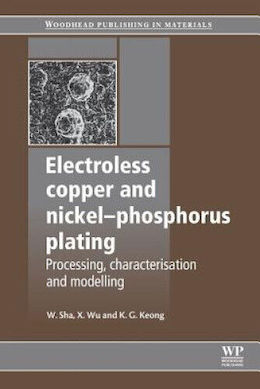
-----
Electroless copper as a heat treat stop-off
Q. Has anyone ever used electroless copper as an effective heat treatment stop-off maskant for either nitride or carburize?
Blair Smithaerospace - Windsor Locks, Connecticut
1996
by Sha, Wu, & Keong

on eBay or Amazon
or AbeBooks
(affil link)
? Hi, Blair: An excellent question! But doesn't the copper have to be reasonably thick for it to work? Is there a thickness spec governing this? Out of curiosity, why would you prefer an electroless maskant?

Ted Mooney, P.E.
Striving to live Aloha
finishing.com - Pine Beach, New Jersey
Ted can be retained for immediate
answers or long term project help
1996
Q. Dear Ted:
Yes, typically the copper thickness must be .0007 to .001 inches thick. The more dense the copper the thinner the deposit thickness required. I am not aware of any specification that governs what thickness the copper plate must be in order to prevent heat treat leakage.
The reason for potentially using an electroless copper maskant is twofold. First, very often the areas which require masking (to prevent heat treatment) are internal diameters which are difficult to plate (even with internal conforming anodes). Second, many of our parts have very tight tolerances and an electroless deposit would allow us to use a masked surface as a reference datum from which we could machine away plate from other features which require heat treatment.
Sincerely,
Blair Smith [returning]aerospace - Windsor Locks, Connecticut
1996
A. Blair,
Semantics: copper does not prevent the heat treatment of steel, it prevents decarburization of the surface of a carbon steel in the hardening process.
Considering the cost of electroless versus modern copper solutions, particularly non cyanide ones, the economics is the cost of masking. Several years ago, my experience with copper from a job shop was poor. We ended up using a salt bath for hardening. Eliminated a number of problems on a complex geometry part. Decarb went to nearly zero.
- Navarre, Florida
1996
Q. Hello.
We are Boronizing 4140 steel parts and the customer wants the cylindrical end masked on 3" of the shaft! We used a water soluble "copper" stop off paste. After boriding, the parts needed to be quenched and tempered. We were told the quench and temper could not be done in a vacuum so the heat treater used no vacuum. We've tried everything to remove the stop off but it was extremely hard and left a pattern in the metal? Do you have a better idea? Thanks.
Jim
- Arlington Texas, USA
October 10, 2019
Q, A, or Comment on THIS thread -or- Start a NEW Thread